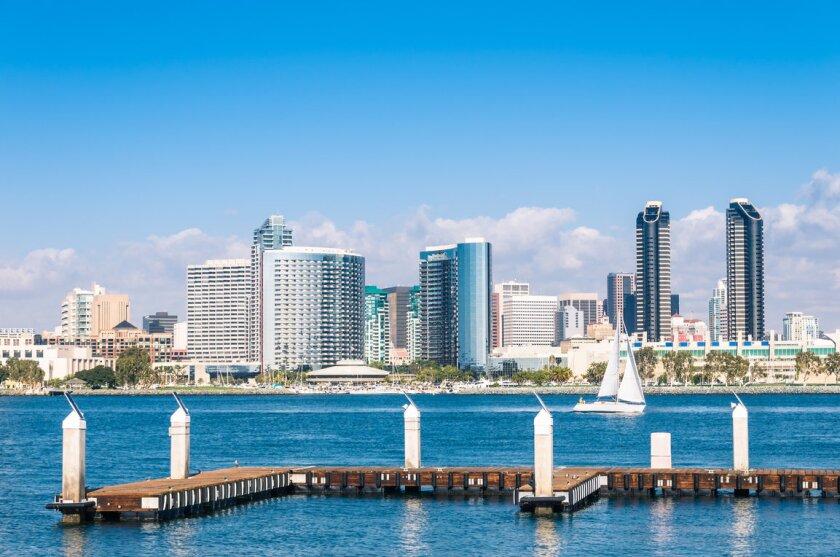
It remains to be seen, however, just how much faster AT&T’s new 5G consumer network will be compared to its current 4G network, and whether it’s enough to persuade consumers to spend roughly $1,000 on a new 5G smartphone that’s compatible to utilize the service.
The gigabit or better speeds promised by 5G depend largely on the particular airwaves used to deliver mobile bandwidth.
At least for now, AT&T isn’t providing 5G to San Diego consumers over turbo-charged airwaves capable of reaching fiber-optic-like download speeds — though it does offer ultra-fast 5G to some businesses via mobile hot spots.
Instead, AT&T is re-purposing certain 4G airwaves to deploy 5G service to consumers in San Diego and four other cities nationwide.
“When we introduced the U.S. to 5G last year, we started with a business-first and experience-based strategy to lay the foundation for innovation to come,” said Thaddeus Arroyo, head of AT&T’s consumer unit, in a statement. “We’re now introducing consumers to the future of wireless with a broad 5G service.”
While AT&T isn’t making speed predictions, “we do expect it to offer a good balance of impressive speeds over broader distances,” said company spokesman Scott Huscher.
The company declined to pin down exactly when its 5G network will go live locally. “Work is well underway for our impending launch in San Diego, which will be one of our first cities,” said Huscher.
The complexity surrounding AT&T’s 5G network announcement highlights how the marketing around 5G can be confusing.
For example, AT&T has touted “5G Evolution” in hundreds of markets in recent years, including displaying the 5Ge icon on subscribers’ phones. Technically, 5G Evolution is faster 4G. Current 4G smartphones lack the capability to access 5G technology.
The hype is likely just getting started. More than 40 network operators globally have launched 5G networks or are planning to early next year— including all four carriers in the U.S.
5G promises gigabit speeds, ultra-low transmission delays and greatly improved network capacity and reliability, said Mike Walkley, a telecommunication analyst with Canaccord Genuity.
“We believe 5G technologies will create compelling new business opportunities including virtual and augmented reality, autonomous driving, industrial Internet of Things, smart cities and more,” he said.
Verizon plugged in 5G in certain neighborhoods in Chicago and Minneapolis in April and now has expanded to 16 additional cities. While coverage remains spotty, the company expects to have 5G in 30 markets by year-end.
Sprint went live with 5G in Atlanta, Dallas, Houston and Kansas City in June, and it has since added four more cities.
T-Mobile served up 5G to six cities this summer, and it announced plans to cover more than 200 million people with low-end 5G service by year-end, delivering what it calls a “foundational layer” of coverage across the country.
AT&T rolled out 5G in 12 cities in late 2018, but only offered it to businesses.
The company’s business-focused service has since expanded to 21 cities, including San Diego. AT&T expects to add nine more by year-end. And it has pledged to deliver nationwide coverage in the first half of next year.
5G is delivered over several airwave frequencies spanning high-band, mid-band and low-band spectrums. Each has strengths and weaknesses.
High frequencies — known as millimeter wave — can deliver vast amounts of data at very high speeds. Verizon has focused heavily on millimeter wave for 5G. It calls its service “ultra wideband.”
AT&T’s millimeter wave is branded “5G+.” T-Mobile has deployed millimeter wave in select neighborhoods in a handful of cities.
While millimeter wave serves up tons of data very fast, its signals don’t travel very far. They’re easily deflected by trees and even rain. To enable widespread millimeter wave coverage, a significant number of additional antennas must be installed.
Mid-band and low-band frequencies travel farther, penetrate buildings and don’t require a dense antenna network.
But they’re also not as fast. Skeptics question whether mid-band and low-band 5G can deliver enough of a performance boost over 4G to lure consumers to upgrade to a more expensive smartphone.
Even in the low- and mid-band frequencies, 5G uses spectrum more efficiently than 4G, said Igal Elbaz, AT&T’s senior vice president of wireless technology, at an investor conference earlier this month.
But when 5G is advertised as being ultra-fast, it’s mostly because of millimeter wave.
AT&T’s consumer 5G network in San Diego is being deployed on low-band, 850 megahertz spectrum, with good coverage over a large part of the region including most of San Diego, Chula Vista and cities along the Interstate 5 and Interstate 15 corridors, including Oceanside and Escondido.
“AT&T is positioning low-band 5G for use in residential, suburban and rural areas, while it offers 5G+ over millimeter wave spectrum for dense, high-traffic areas like stadiums, shopping centers and university campuses,” said Sue Rudd, director of service provider analysis at industry research firm Strategy Analytics.
In addition to San Diego, AT&T is launching low band 5G in San Francisco and San Jose.
(c)2019 The San Diego Union-Tribune. Distributed by Tribune Content Agency, LLC.




